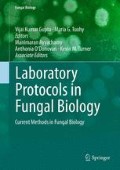Abstract
A method based on solid phase microextraction coupled to gas chromatography–mass spectrometry (GC–MS) for the detection and identification of microbial volatile organic compounds (MVOCs) in the headspace of filamentous fungi is presented. MVOCs are identified by comparison of mass spectra and linear temperature programmed retention indices (LTPRIs) with database entries and LTPRIs published in literature. The presented method enables the monitoring of the formation of volatile metabolites for defined time intervals during cultivation of the investigated fungus. The experimental procedure is exemplified with Fusarium graminearum and Trichoderma atroviride but can also be used to detect, identify and profile MVOCs produced by other filamentous fungi.
Access this chapter
Tax calculation will be finalised at checkout
Purchases are for personal use only
References
Wheatley RE (2002) The consequences of volatile organic compound mediated bacterial and fungal interactions. Antonie Van Leeuwenhoek 81:357–364
Schnürer J, Olsson J, Börjesson T (1999) Fungal volatiles as indicators of food and feeds spoilage. Fung Genet Biol 27:209–217
Korpi A, Järnberg J, Pasanen AL (2009) Microbial volatile organic compounds. Crit Rev Toxicol 39:139–193
Reino JL, Guerrero RF, Hernández-Galán R, Collado IG (2008) Secondary metabolites from species of the biocontrol agent Trichoderma. Phytochem Rev 7:89–123
Magan N, Evans P (2000) Volatiles as an indicator of fungal activity and differentiation between species, and the potential use of electronic nose technology for early detection of grain spoilage. J Stored Prod Res 36:319–340
Nemčovič M, Jakubíková L, Víden I, Vladimír F (2008) Induction of conidiation by endogenous volatile compounds in Trichoderma spp. FEMS Microbiol Lett 284:231–236
Keszler À, Forgács E, Kótai L (2000) Separation and identification of volatile components in the fermentation broth of Trichoderma atroviride by solid phase extraction and GC/MS. J Chromatogr Sci 38:421–424
Larsen TO, Frisvad CF (1995) Comparison of different methods for collection of volatile chemical markers from fungi. J Microbiol Methods 24:135–144
Wheatley R, Hackett C, Bruce A, Kundzewicz A (1997) Effect of substrate composition on production of volatile organic compounds from Trichoderma spp. Inhibitory to wood decay fungi. Int Biodeter Biodegr 39:199–205
Meruva NK, Penn JM, Farthing DE (2004) Rapid identification of microbial VOCs from tobacco molds using closed-loop stripping and gas chromatography/time-of-flight mass spectrometry. J Ind Microbiol Biotechnol 31:482–488
Deetae P, Bonnarme P, Spinnler HE, Helinck S (2007) Production of volatile aroma compounds by bacterial strains isolated from different surface-ripened French cheeses. Appl Microbiol Biotechnol 76:1161–1171
Fiedler K, Schütz E, Geh S (2001) Detection of microbial volatile organic compounds (MVOCs) produced by moulds on various materials. Int J Hyg Environ Health 204:111–121
Demyttenaere JCR, Moriña RM, De Kimpe N, Sandra P (2004) Use of headspace solid-phase microextraction and headspace sorptive extraction for the detection of the volatile metabolites produced by toxigenic Fusarium species. J Chromatogr A 1027:147–154
Van Lancker F, Adams A, Delmulle B, De Saeger S, Moretti A, Van Peteghem C et al (2008) Use of headspace SPME-GC–MS for the analysis of the volatiles produced by indoor molds grown on different substrates. J Environ Monit 10:1127–1133
Tholl D, Boland W, Hansel A, Loreto F, Röse USR, Schnitzler JP (2006) Practical approaches to plant volatile analysis. Plant J 45:540–560
Arthur CL, Pawliszyn J (1990) Solid phase microextraction with thermal desorption using fused silica optical fibers. Anal Chem 62:2145–2148
Jeleń HH (2003) Use of solid phase microextraction (SPME) for profiling fungal volatile metabolites. Lett Appl Microbiol 36:263–267
Stein SE (1999) An integrated method for spectrum extraction and compound identification from gas chromatography/mass spectrometry data. J Am Soc Mass Spectrom 10:770–781
Hiller K, Hangebrauk J, Jäger C, Spura J, Schreiber K, Schomburg D (2009) MetaboliteDetector: comprehensive analysis tool for targeted and nontargeted GC/MS based metabolome analysis. Anal Chem 81:3429–3439
Stoppacher N, Kluger B, Zeilinger S, Krska R, Schuhmacher R (2010) Identification and profiling of volatile metabolites of the biocontrol fungus Trichoderma atroviride by HS-SPME-GC–MS. J Microbiol Methods 81:187–193
Van Den Dool H, Kratz P (1963) A generalization of the retention index system including linear temperature programd gas–liquid partition chromatography. J Chromatogr A 11:463–471
Lu H, Dunn BD, Shen H, Kell DB, Liang Y (2008) Comparative evaluation of software for deconvolution of metabolomics data based on GC-TOF-MS. Trends Anal Chem 27:215–227
Styczynski MP, Moxley JF, Tong LV, Walther JL, Jensen KL, Stephanopoulos GN (2007) Systematic identification of conserved metabolites in GC/MS data for metabolomics and biomarker discovery. Anal Chem 79:966–973
NIST Mass Spec Data Center, Stein SE (2011) Retention indices. In: Linstrom PJ, Mallard WG (eds). NIST Chemistry WebBook. NIST Standard Reference Database Number 69. Gaithersburg, MD: National Institute of Standards and Technology; 2011: 20899, http://webbook.nist.gov (retrieved April 27, 2011)
Acknowledgement
The financial support by the Austrian Science Fund (FWF projects F3702 and F3706) is gratefully acknowledged.
Author information
Authors and Affiliations
Editor information
Editors and Affiliations
Rights and permissions
Copyright information
© 2013 Springer Science+Business Media, LLC
About this chapter
Cite this chapter
Kluger, B., Zeilinger, S., Wiesenberger, G., Schöfbeck, D., Schuhmacher, R. (2013). Detection and Identification of Fungal Microbial Volatile Organic Compounds by HS-SPME-GC–MS. In: Gupta, V., Tuohy, M., Ayyachamy, M., Turner, K., O’Donovan, A. (eds) Laboratory Protocols in Fungal Biology. Fungal Biology. Springer, New York, NY. https://doi.org/10.1007/978-1-4614-2356-0_42
Download citation
DOI: https://doi.org/10.1007/978-1-4614-2356-0_42
Published:
Publisher Name: Springer, New York, NY
Print ISBN: 978-1-4614-2355-3
Online ISBN: 978-1-4614-2356-0
eBook Packages: Biomedical and Life SciencesBiomedical and Life Sciences (R0)

